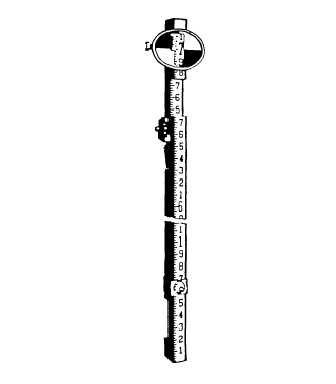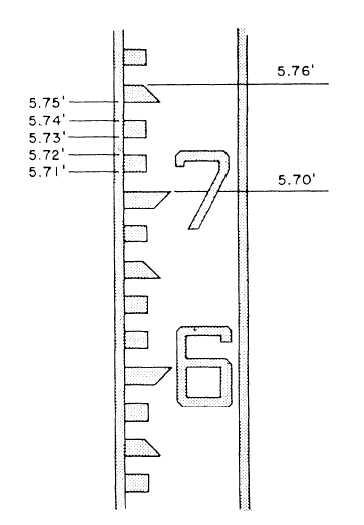ground. Make any slight adjustments to level the head
further by moving the third leg a few inches in or out
before pressing it into the ground.
When placing the instrument onto the tripod, grip
the instrument firmly to avoid dropping it while you
are mounting it on the tripod. The instrument should
be screwed down to a firm bearing, but not so tightly
that it binds or the screw threads strip.
LEVEL ROD
The most often used level rod is the Philadelphia
rod, as shown in figure 15-43. It is a graduated
wooden rod, made of two sections, and can be
extended from 7 feet to 13 feet.
Each foot is subdivided into hundredths of a foot.
Instead of each hundredth of a foot being marked with
a line or tick, the distance between alternate
hundredths is painted black on a white background.
Thus the distance between the colors: the top of the
black is even values, the bottom of the black is odd
values, the tenths are numbered in black, the feet in
red.
Figure 15-43.—Philadelphia level rod with target.
Direct Reading
Direct readings are taken off a self-reading rod,
held plumb on a point by a rodman. If you are working
to tenths of a foot, it is relatively simple to read the
foot mark below the cross hair and the tenth mark
which is closest to the cross hair. But, working to the
hundredths of a foot is more complicated. For
example, suppose you are making a direct reading
which comes out as 5.76 feet. On a Philadelphia rod,
the graduation marks are 0.01 foot wide and are 0.01
foot apart. For a reading of 5.76 feet, there are three
black graduations between the 5.70-foot mark and the
5.76-foot mark, as shown in figure 15-44. Since there
are three graduations, the rod may be misread as 5.73
feet instead of 5.76 feet.
The 5-foot mark or the 6-foot mark does not show
in figure 15-44. While sighting through the level
instrument, you might not be able to see the foot
Figure 15-44.—Direct reading of 5.76 feet on a Philadelphia
rod.
15-25



